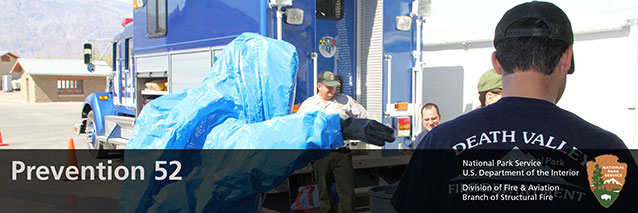
What Would You Do?
What do all three of these situations have in common and what should you do? These three situations describe hazardous materials incidents.
- While walking through the campground on your way back from giving an interpretive campfire program, you smell the strong odor of propane and hear a loud hissing sound coming from a propane tank serving the government housing area.
- Late one afternoon, while working in the park administrative office, you smell a strange odor and hear a number of people beginning to complain of headaches.
- A visitor runs over a large rock with his car, puncturing the gas tank. Gasoline is seen flowing across the parking lot and into a nearby stream drainage.
Dangerous goods or hazardous materials (hazmats) are substances that have harmful characteristics, i.e., bad stuff can happen when they are around. Automotive shops, carpenter and trails shops, janitorial closets, and water treatment plants are just a few of the places in our parks that may contain hazardous materials. In addition, hazardous materials are being transported through our parks everyday by delivery trucks, contractors, and visitors. The dangers posed by hazardous materials include the risk of fire or explosion and many health-related injuries, some of which may be immediate and some of which may develop into health issues years later. Also, the potential negative effects on the environment from a spill or release are significant.
All chemicals readily used today are required to have material safety data sheets (MSDS). MSDS provide information about dangers posed by a substance, protective and first aid procedures, and proper handling and storage guidelines. If you need an MSDS for a substance, contact the manufacturer. Most will have a copy available online.
Hazardous materials should be stored properly manner to minimize risks. Some cleaning chemicals should not be mixed together. Refer to the MSDS before using or storing any chemicals. Each park should have a hazardous materials coordinator. If you don't know who serves in this role, contact your park's safety officer.
What should you do if you find yourself in one of the situations posed earlier? The best procedure is to evacuate the building or area. The safest place to go is uphill and upwind. Depending upon local protocol, call the fire department or park dispatch immediately. Firefighters and other hazmat responders are trained and equipped to deal with these problems and will know whom to contact to properly mitigate the incident, if they are not equipped to do so.
Fire Info for You
If you operate an emergency vehicle as part of your duties, ensure that there is a current Emergency Response Guide (ERG) available for quick reference. This book can be used to identify many hazardous materials from a distance and gives general mitigation and protective action guidelines. A free ERG app for your iPhone or Android can be found on the U.S. Department of Health and Human Services website.
Take Action
Take the time to identify any chemicals stored or used in your workplace and ensure that they are stored properly. Ensure that an MSDS is available for each chemical.
NPS Fire Facts
The NPS has developed a hazardous materials course, called HAZWOPER, for all employees to ensure employee safety in the event of a hazmat incident. These courses are available at numerous locations throughout the year. Contact your regional HAZWOPER coordinator for more information on these courses and their current schedule of offerings.
All structural firefighters are required to have hazardous materials training. For NPS firefighters, you must complete Hazardous Materials Awareness (8-hour course) and Operations (16-hour course). These requirements can be met by completing the associated NPS HAZWOPER programs. If you seek national and interagency recognition, you must be in compliance with the National Fire Protection Association (NFPA) standards, which means completion of the associated NFPA 472, Standard for Competence Responders to Hazardous Materials/Weapons of Mass Destruction classes. Firefighters seeking ProBoard accreditation must be NFPA 472-certified.
To learn more about NPS emergency preparedness regarding hazardous materials, agency classes, and additional contacts, visit the Environmental Compliance and Response Branch Emergency Preparedness web page on InsideNPS.
Last updated: November 2, 2016
